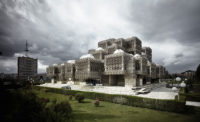This carefully prepared anthology dedicated to wood explores the medium through multiple lenses. Composed of three segments, its various writers bring perspectives ranging in disciplines to allow for a broader cultural reading than any conventional book on wood technologies. Acknowledging the already present and looming crisis of climate change as a central protagonist, the book also positions the balance of merits and liabilities in developing an attitude toward the production of wood, allowing the readers to better understand how a sustainable production of wood is a plan that cannot occur as a single decision but as something that requires ongoing efforts over years, administrations, nations, and cultures.
The subtitular material is explored in the section “From Forest to Timber,” a foundational starting point, inspecting the tree from its botanical roots to the logistics of its forestry management. Contrary to the oft-held misconception of wood’s being a naturally renewable resource, producing the illusion of infinite bounty, the authors recenter the discussion on the sheer fragility of its management, the delicate role it has in calibrating the climatic environment, and the long-term planning required to oversee its sustainable use. In the face of the present architectural arms race to build enlightened wood structures, it is a sobering reminder that this commitment must have a sustained vision longer than the fascinations of this historical moment.
“From Timber to Architecture” continues the process, where the diverse means and methods of construction gain agency in the conceptualization of architecture itself—where materiality contains a cultural value beyond the mere specification of matter once the architecture is in place. Here the anatomy of wood as a complex organism is articulated, its historic and delicate relationship to fire framed, and its related details delineated. This second segment of the book contains the lion’s share of its research, projecting forward and speculating on the types of explorations to come, from assembly to disassembly, from handcraft to digital manufacturing, and the catalytic details that allow for unprecedented technological change. Many essays in this section maintain an air of scholarly distinction by incorporating broader historical and cultural references, while other essays serve as no more than extended captions to images; however, together they cohere as an important narrative and an introduction to areas of inquiry for the reader.
Foreshadowing the future, “Architecture in Timber” is a series of case studies meticulously curated from contemporary culture with an eye not only toward technical innovations but also architectural sophistications of various types. Beginning with a host of Swiss examples from the 1980s and 1990s, this section highlights Peter Zumthor, Marcel Meili, and Herzog & de Meuron, among others, with a focus on the artful tectonic virtuosity they reintroduced to wood architecture. The collection expands culturally with geographic examples in South America, Europe, Asia, and beyond, helping to conceptually broaden how wood has been rethought in recent years. Peris + Toral’s Social Dwellings in Spain stand out in their raw simplicity of structure, seemingly repetitive in the spatial cadence of units while infinitely typologically malleable in their programming of spaces. In contrast, White Arkitecter’s Sara Cultural Center in Sweden stands out not only for the complexity of its spatial and constructive logics, but its all-important exploration of unprecedented heights in wood architecture—what many other countries have not yet yielded to due to outmoded code restrictions.
The anthology closes with manifestos by Markus Schaefer, Helene Romakin, and the duo Andreas Jud and Stefan Kurath, essays that amplify the urgency of our current moment and call for a new type of consciousness in the age of the Anthropocene. They are an alert that the signs of the future are already present among us, and that a reformed idea about nature must be defined, not only to build our planet, but also to preserve it.







Post a comment to this article
Report Abusive Comment